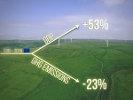
Greenhouse gas emissions in the European Union were reduced by 23% between 1990 and 2016, while the economy grew by 53% over the same period, according to the latest EU climate action progress report.
The report "Two years after Paris – Progress towards meeting the EU's climate commitments" shows that while economic growth has recently picked up, the EU remains firmly on track to meet its 2020 greenhouse gas emissions reduction target. In 2016, EU emissions decreased by 0.7% while GDP grew by 1.9%. The EU is one of the major economies with the lowest per capita emissions, and the emissions per unit of GDP continue to fall.
Commissioner for Climate Action and Energy Miguel Arias Cañete said: "Two years after the adoption of the Paris Agreement, the EU remains fully committed to reducing its domestic emissions by at least 40% between 1990 and 2030. We are on track to meet our 2020 target and close to finalising our climate legislation for the next decade. Our emissions decline while the economy grows, largely thanks to innovative technologies, showing that growth and climate action can go hand in hand. However, there are still challenges ahead, as transport emissions in the EU continue to grow. This is why the Commission will present tomorrow measures to slash emissions from cars and vans in the decade starting 2021"
The EU is set to take three key legislative steps in 2018 to put the bloc on a path to achieving its 2030 emissions reduction target – namely reforming the EU Emissions Trading System (ETS) for the period after 2020, setting binding national emissions targets for sectors outside the ETS and integrating the land use, land use change and forestry (LULUCF) sector into the EU's emissions reduction framework.
As part of the 'Clean Energy for all Europeans' package, the European Commission has also proposed legislation on renewable energy, energy efficiency and governance of the Energy Union. These three legislative acts are also expected to be adopted next year.
The EU is also ensuring that action is taking place on the ground, notably with large financing programmes for example for innovation, investments in renewable energy, better energy efficiency and more efficient transport systems.
Over the period 2013–2016, the EU Emissions Trading System provided Member States with EUR 15.8 billion in revenues, out of which approximately 80% will be used for climate and energy purposes, such as renovating housing and investing in renewable energy.
The regulation on the governance of the Energy Union aims to establish a common EU framework for climate and energy policy, with integrated planning and reporting tools. This will enable monitoring of progress towards targets and long-term planning to achieve a balance between emissions and removals in the second half of the century, in line with the Paris Agreement. Long-term planning will also provide security for investments and mobilise the resources needed for the transition to a low-emission economy, which will also create growth and jobs.
The progress report also looks at the EU's contribution to international climate action. In 2016, the EU continued to be actively involved in global climate policy, for instance in the aviation and maritime sectors. The EU and its Member States continued to be a major provider of climate finance to developing countries, increasing their overall contribution to last year reach EUR 20.2 billion.
Read more:
Details
- Publication date
- 7 November 2017
- Author
- Directorate-General for Climate Action
